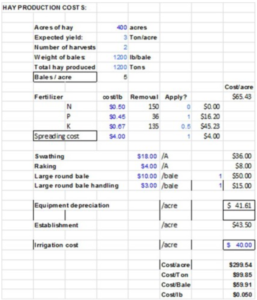Join our Mailing list!
Get all latest news & be the first to know about upcoming events.
By Dan Rasmussen
Winter feeding costs are typically the single greatest line-item cost in most cow-calf budgets. A few years ago, Jim Gerrish, a well known range consultant from Patterson, Idaho, wrote an article* on how to calculate the cost of producing one ton of hay on your ranch or farm. Jim found his clients cost of production ranged from $70 to $140 per ton (2013) if all production costs were calculated.
In the article, Jim explains, “The obvious costs of making hay are the seed, fertilizer, equipment, and fuel for which we see an actual invoice. If we’re paying hired labor, we see the cost in their paycheck. If we are both management and labor for our farm, we usually don’t pay ourselves a decent wage. Most hay producers know there is something called equipment depreciation, but few actually put it into their accounting when figuring the cost of making hay. On non-farming operations, equipment depreciation may be one of your highest costs. If you let someone else make your hay, you eliminate that cost”.

Jim goes on, “There is another whole set of costs to hay making we ignore. Those are the opportunity costs of land and labor. What else could you be doing with your hay fields if they weren’t being made into hay”. “What could you and/or your employees be doing if you weren’t making hay? Building or moving fence and water systems? Better managing the livestock you have? Handle more livestock? Spend more time on marketing? Making hay on your own land costs you far more than you might imagine. It costs you your time!”
Mr. Gerrish created a “Hay Cost Calculator” to help his clients determine if they are better off producing their own hay or buying hay from a neighbor. You can plug your own numbers into this sample Spreadsheet and see what a ton of hay is costing you to produce.
Hay Cost Calculator by Jim Gerrish. From his book, “Kick the Hay Habit-A practical Guide to Year Round Grazing”.** Jim explains, “You should be able to come up with all the information needed to fill in the necessary spaces to determine your own cost of producing hay from your ranch. The values for harvesting are based on typical custom rates (from 2013). With fuel prices increasing again, custom rates are likely heading upward as will fertilizer, equipment, and all inputs made from iron or oil”.
Each time you remove a hay crop from the field you are removing nutrients from the soil. Over time, this will greatly diminish soil health. Poor soil health equals decreased production and profit/acre.
The majority of hayfields in west river South Dakota have very poor soil health as a result of removing the organic matter, for a 100 years in some cases. These fields often show signs of soil erosion because organic matter is so low rain water runs off taking topsoil with it. During the 2021-22 drought, production on these hayfields was very low.
Grazing hayfields allows you to leave standing forage which turns into ground cover on the soil and helps feed the soil microbes. If you choose to cut hay, feeding the hay back on the field is one way of keeping the nutrients in the soil. When you buy someone else’s hay, you’re also buying their fertility.
In summary, the profitability of making hay on your ranch comes down to running all the numbers and calculating your cost per ton. Then using this information to determine if making hay is the right decision for your operation.
*Why you should be out of the Hay Business, By Jim Gerrish, American Grazing Lands Services, LLC, Patterson, Idaho
**Kick the Hay Habit-A practical Guide to Year Round Grazing, By Jim Gerrish
Get all latest news & be the first to know about upcoming events.